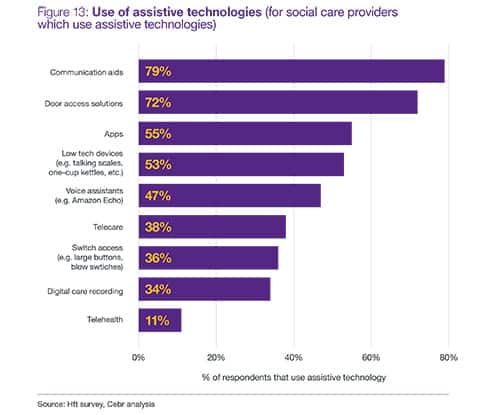Research reveals big potential for social care providers to enhance services with assistive tech

New research by national charity HfT has identified that social care organisations are yet to fully embrace assistive technologies as a core element of their service provision, presenting an opportunity for retailers and suppliers in the sector.
The findings were disclosed in HfT’s Sector Pulse Check for 2019, with 77 social care providers specialising learning disability care, elderly care, and physical disability care responding to the survey.
Carried out business consultancy Cebr since 2016, the annual report analyses the effects of changes to the social care sector each year, with a particular focus on its financial health and financial pressures.
In its most recent report for last year, the study found that whilst social care organisations had adopted some assistive technology, there was “a growing potential for social care providers to make use of new ways to improve their services.”
Assistive technology refers to a broad range of supportive equipment and services to help people remain safe, comfortable and more independent, ranging from personal alarms and falls sensors to mobility devices and simple aids to daily living.
According to the Sector Pulse Check, 76 per cent of respondents confirmed using assistive technologies but only 19 per cent said use of assistive technologies formed a “core part of their service provision.”
A further 19 per cent said they did not use assistive technology at all.
The most and least widely used assistive tech
Of the different types of assistive technologies used by social care providers, communication aids were the dominant product category, with 79 per cent of organisations using some form of communication equipment.

Door access solutions were a close second at 72 per cent, whilst around half of the respondents highlighted using apps, low-tech devices such as talking scales & one-cup kettles, as well as voice assistants such as Amazon’s Alexa.
Interestingly, only 38 per cent of respondents confirmed the use of telecare solutions.
It comes as the telecare market prepares to shift to digital connections and away from analogue, which still represents 95 per cent of connections on the market. It is expected the shift will rapidly increase telecare adoption over the coming years, with multiple players recently jostling for position through investments and acquisitions.
Additionally, the HfT’s report noted that telehealth – tech used to enable healthcare professionals to remotely monitor vital data on patient’s health – was the least used assistive technology with just 11 per cent.
Why social care providers use assistive tech
Questioning social care organisations about why they use assistive technology, the overwhelming response was to increase independence and increase communication, at 79 and 72 per cent respectively.

Sensory support and safety also ranked highly amongst reasons to use assistive tech in social care provision, whilst less than half (40 per cent) used equipment to monitor health or improve an individual’s fitness.
A significant 81 per cent of social care organisations also said they believed they were not using assistive technologies to their full potential but 76 per cent recognised assistive technology’s ability to improve outcomes for the people they support.
Barriers to adoption
Despite recognising the advantages of incorporating and embedding assistive technologies into the social care services they provide; respondents revealed a number of barriers preventing wider adoption.
In particular, the report stated that to “realise the full potential of new technology requires training and time to embed new skills within the workforce. It may be the case that many staff in social care organisations are very busy, and so struggle to make the time to properly understand the full potential of the assistive technology available to them.”
Cost, however, remained the biggest obstacle facing social care providers’ ability to adopt assistive technologies, with three in four organisations stating they could not afford it.
Additionally, an unwillingness by local authorities to fund assistive technology was also identified by 71 per cent.

Importantly, 59 per cent pointed out that a lack of awareness of assistive technology amongst organisations was also hampering care providers’ willingness to fully embrace new tech and equipment.
“Even organisations who do have the budget to purchase assistive technology still need to invest time in understanding what would work best for the people they support,” stated the report.
“Many staff are also unsure how to use new technologies, which dissuades organisations from purchasing new equipment, as they fear that it will not be used by staff.”
Growing potential in the assistive technology market
In spite of the barriers, a key finding of the research underlined the large potential that exists in the assistive tech market to social care providers, with a notably low number (12 per cent) of respondents stating that the equipment does not exist to meet their needs.
This would suggest that mobility and independent living retailers supplying assistive technology could find an attractive and untapped customer base amongst social care providers for assistive tech solutions if they are able to overcome the barriers of funding, staff training and awareness.


